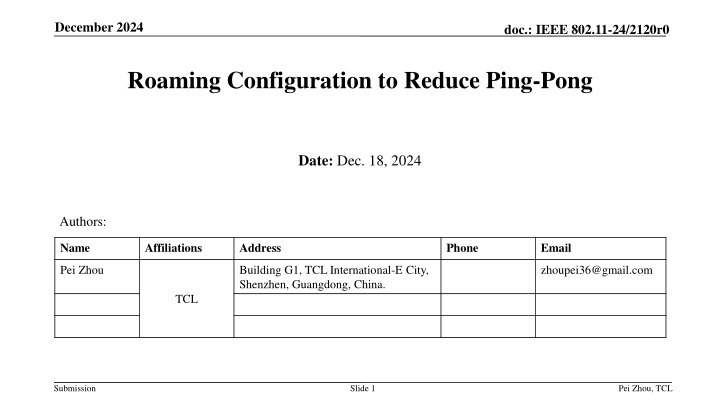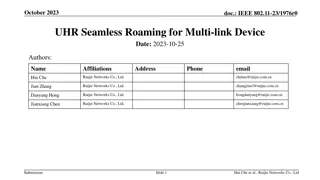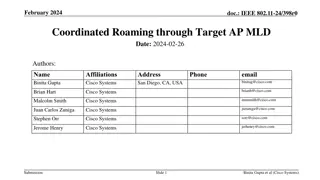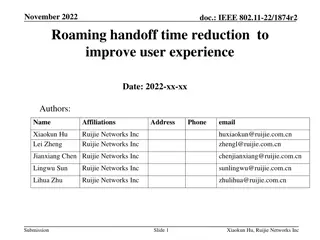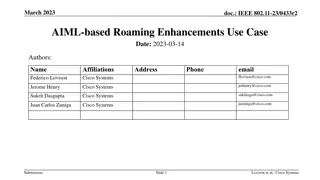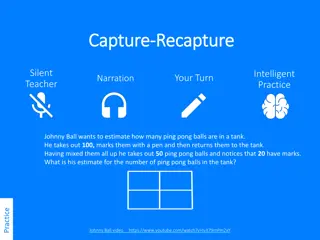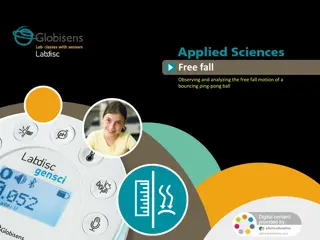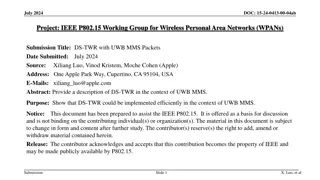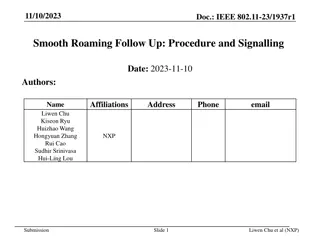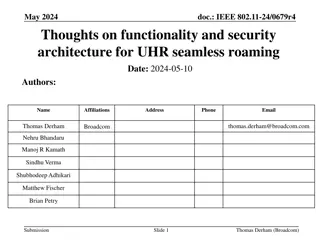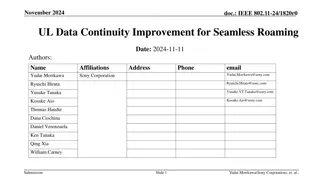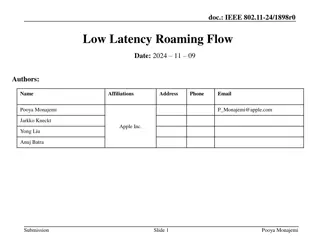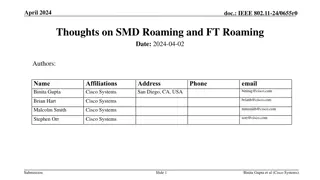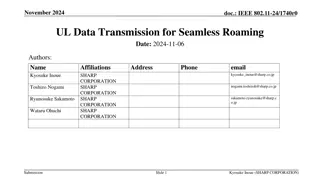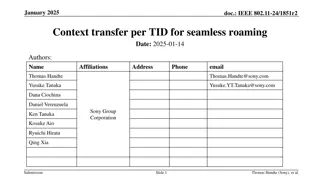Roaming Configuration to Reduce Ping-Pong Issue in IEEE 802.11-24
Seamless roaming in wireless communications is essential for a better user experience. This document proposes a Roaming Configuration mechanism to minimize the ping-pong effect caused by frequent handovers between Access Points (AP) in IEEE 802.11-24 networks. By defining accurate triggering conditions and roaming configurations, this solution aims to enhance the Quality of Service (QoS) and Quality of Experience (QoE) for users. Case studies illustrate how Roaming Configurations can effectively manage roaming points and improve overall network performance.
Download Presentation

Please find below an Image/Link to download the presentation.
The content on the website is provided AS IS for your information and personal use only. It may not be sold, licensed, or shared on other websites without obtaining consent from the author.If you encounter any issues during the download, it is possible that the publisher has removed the file from their server.
You are allowed to download the files provided on this website for personal or commercial use, subject to the condition that they are used lawfully. All files are the property of their respective owners.
The content on the website is provided AS IS for your information and personal use only. It may not be sold, licensed, or shared on other websites without obtaining consent from the author.
E N D
Presentation Transcript
December 2024 doc.: IEEE 802.11-24/2120r0 Roaming Configuration to Reduce Ping-Pong Date: Dec. 18, 2024 Authors: Name Affiliations Address Phone Email Pei Zhou Building G1, TCL International-E City, Shenzhen, Guangdong, China. zhoupei36@gmail.com TCL Submission Slide 1 Pei Zhou, TCL
December 2024 doc.: IEEE 802.11-24/2120r0 Introduction Seamless Roaming has become the dominant feature of UHR A lot of roaming related motions (e.g., Motion #2, Motion #26, Motion #27, Motion #44, Motion #162) has passed [1] Seamless Roaming provides a non-AP MLD continuous and reliable wireless communications However, frequently handover between neighboring AP MLDs causes a bad QoS/QoE Few contributions has discussed how to improve ping-pong issue Contribution [2] proposed a new concept Client Experience Score + areas for improvement Contribution [3] discussed how AP can use the BTM Status frame to warn/avoid ping-pong In this contribution, we propose a flexible and accurate Roaming Configuration mechanism to reduce the potential Ping-Pong issue Submission Slide 2 Pei Zhou, TCL
December 2024 doc.: IEEE 802.11-24/2120r0 Define Roaming Configurations To avoid potential ping-pong, we need to configure the accurate triggering conditions of non-AP MLD s roaming execution Triggering conditions include one or more of the following Condition A: Roaming configurations between non-AP MLD and Serving AP MLD Condition B: Roaming configurations between non-AP MLD and Candidate AP MLD(s) Others are TBD Roaming configurations include one (two) or more of the following Reference value (e.g., RSSI, delay, Data Rate): Ref Hysteresis value: Hys Threshold value: Ths Others are TBD Submission Slide 3 Pei Zhou, TCL
December 2024 doc.: IEEE 802.11-24/2120r0 Case study Ref At legacy roaming point, frequent ping-pong may occur between two AP MLDs (e.g., RSSI) Serving AP MLD Target AP MLD So, we can use Roaming Configurations to the change the roaming point Example 1: (Leaving condition) Condition A: RSSI of Serving AP MLD worse than Ths_1 Ref_1 + Hys_1 < Ths_1 Example 2: (Entering condition) Condition B: RSSI of Candidate AP MLD better than Ths_2 Ref_2 + Hys_2 > Ths_2 Hys_1 Hys_2 Ths_2 Roaming Trigger area (+Condition B) Ths_1 To make more reliable roaming experience, Condition A and Condition B can be used together Roaming Trigger area (+Condition A) Position Roaming Trigger point (legacy) Submission Slide 4 Pei Zhou, TCL
December 2024 doc.: IEEE 802.11-24/2120r0 Roaming Configuration Procedures Serving AP MLD Non-AP MLD Target AP MLD(s) MLD(s) Target AP Roaming Configurations can be initiated by non-AP MLD or Serving AP MLD before roaming Figure shows an example of non-AP MLD initiated Roaming Configurations Original Link Decides to use roaming configuration Roaming Configuration Request Option 1 Option 1 only configures Condition A Once Condition A (e.g., Condition A-1 in slide 3) is met, non- AP MLD is free to execute roaming Option 2 only configures Condition B Once Condition B (e.g., Condition B-1 in slide 3) is met, non- AP MLD is free to execute roaming Option 3 configures both Condition A and B Both Condition A and B (e.g., Condition A-1 and B-1 in slide 3) are met, non-AP MLD is permitted to execute roaming (i.e., send Roaming Request) Roaming Configuration Response Roaming Configuration Request Option 2 Roaming Configuration Response Roaming Configuration Request Roaming Configuration Response Roaming Configuration Request Option 3 Roaming Configuration Response Roaming Configuration Confirm (optional) Roaming Decision Roaming Request Note: it is TBD to use Roaming Configuration Request/ Response frames. or Roaming Request Submission Slide 5 Pei Zhou, TCL
December 2024 doc.: IEEE 802.11-24/2120r0 Summary Roaming Configurations make precise roaming decisions to avoid ping-pong Open Discussions: Detailed design of Roaming Triggering Conditions, e.g., Condition A, Condition B, other conditions mandatory or optional Roaming Configuration Procedures, Roaming Configuration Sequence(s), e.g., Condition A first and then Condition B e.g., Stop Condition B when finding the first Candidate AP MLD that meets Condition B Configuration signaling/frame formats Roaming Configuration parameters, e.g., Reference value, Hysteresis value, and Threshold value mandatory or optional Submission Slide 6 Pei Zhou, TCL
December 2024 doc.: IEEE 802.11-24/2120r0 Straw Poll 1 Do you agree to add the following text to the TGbn SFD: TGbn defines a mechanism that enables a non-AP MLD to configure roaming trigger conditions with Serving AP MLD and/or Target AP MLD(s) to reduce ping-pong. Note: Roaming trigger conditions are the conditions that trigger a non-AP MLD to initiate roaming procedure. Detailed triggering roaming conditions are TBD. Y/N/A Submission Slide 7 Pei Zhou, TCL
December 2024 doc.: IEEE 802.11-24/2120r0 References [1] 11-24-0209-06-00bn-specification-framework-for-tgbn [2] 11-24-1123-01-00bn-client-experience-reporting [3] 11-24-0519-02-00bn-pingpongwarningforuhr Submission Slide 8 Pei Zhou, TCL
